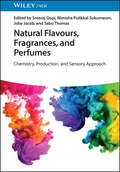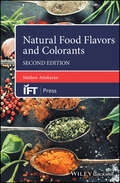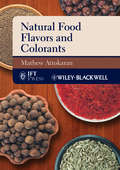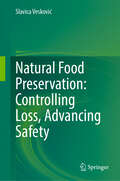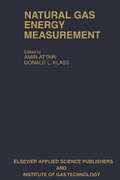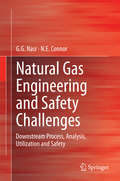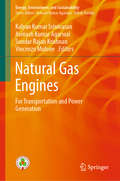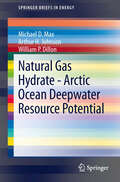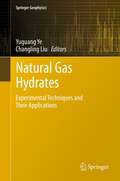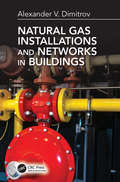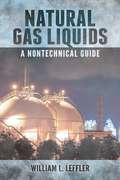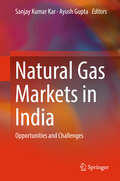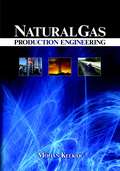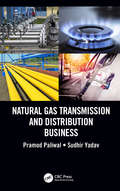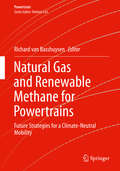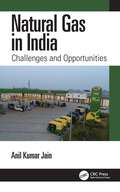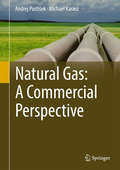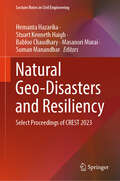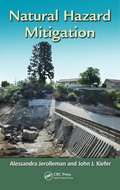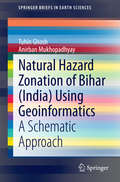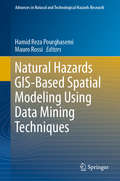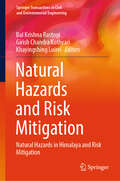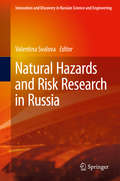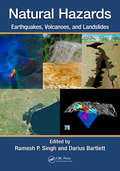- Table View
- List View
Natural Flavours, Fragrances, and Perfumes: Chemistry, Production, and Sensory Approach
by Sabu Thomas Sreeraj Gopi Nimisha Pulikkal Sukumaran Joby JacobNatural Flavours, Fragrances, and Perfumes Explore this one-stop resource on every relevant aspect of natural flavors and fragrances The use of sensory science has the potential to give scientists, researchers, and industry specialists a way to overcome the challenges in nutraceuticals and, more generally, in the functional food industry. Flavor and fragrance have the potential to significantly influence consumer satisfaction with products and its success in the marketplace. In order to effectively produce and optimize a customer’s experience in both food and household products, it is essential to have a strong understanding of the fundamentals of chemistry and physicochemical processes. Natural Flavours, Fragrances and Perfumes offers a comprehensive look at the sensory sciences necessary to produce the most appealing olfactory responses derived from natural resources for consumers – from the analysis and biomolecular aspects of natural products to the processing and isolation of desired products, from the perceptual properties to regulatory aspects. Specifically, the book presents novel approaches to the processes involved in producing plant-derived functional products by examining how characteristic flavors arise due to complex interactions between hundreds of molecules, as well as studying the physiological variables that affect flavor perception. Natural Flavours, Fragrances, and Perfumes readers will also find: Insights into the identification and characterization of plant volatiles, as well as chromatography techniques for sensory fingerprints Chapters devoted to biosynthesis and metabolic pathways for the development of household products composed of organic materials Additional chapters on the advances in flavor science, on technological advances in the effective delivery of flavor, and challenges in the retention and release of flavor Natural Flavours, Fragrances, and Perfumes is a useful reference for chemists of all kinds, food scientists, biotechnologists, and perfumers, as well as those studying in these fields.
Natural Food Colorants: Science and Technology
by Gabriel J. Lauro Jack FrancisThis work focuses on the preparation, structure, chemistry, functional properties, stability, handling and applications of naturally-derived colorants approved for use in food products in the USA, Europe and Asia. It presents studies that investigate whether natural colorants reduce risk of heart disease, specific types of cancer, and other conditi
Natural Food Flavors and Colorants
by Mathew AttokaranAlthough many foods are appealing, and even perceived as natural, in spite of containing synthetic additives, consumer increasingly prefer food products which are fully natural. This has driven an increase in the use of, and interest in, food additives derived from biological sources. Of particular interest are natural food flavors and colors, which have started to play a major role in food processing.This volume presents practical information on over 80 natural extracts that can be used as food flavors and colors, drawing on the author's 50 years of food chemistry and technology expertise in both research and industry. The book is divided into three parts: Part I deals with manufacture, quality, analysis, and regulatory aspects. Part II describes the various sources of natural flavors and colorants that are currently available, alphabetized for convenient reference. Part III covers future directions that can be pursued by research workers and manufacturers.Food scientists, researchers and product development professionals alike will find Natural Food Flavors and Colorants an invaluable resource for understanding and using these commercially important natural food ingredients.
Natural Food Flavors and Colorants (Institute of Food Technologists Series)
by Mathew AttokaranAlthough many foods are appealing, and even perceived as natural, in spite of containing synthetic additives, consumer increasingly prefer food products which are fully natural. This has driven an increase in the use of, and interest in, food additives derived from biological sources. Of particular interest are natural food flavors and colors, which have started to play a major role in food processing. This volume presents practical information on over 80 natural extracts that can be used as food flavors and colors, drawing on the author's 50 years of food chemistry and technology expertise in both research and industry. The book is divided into three parts: Part I deals with manufacture, quality, analysis, and regulatory aspects. Part II describes the various sources of natural flavors and colorants that are currently available, alphabetized for convenient reference. Part III covers future directions that can be pursued by research workers and manufacturers. Food scientists, researchers and product development professionals alike will find Natural Food Flavors and Colorants an invaluable resource for understanding and using these commercially important natural food ingredients.
Natural Food Preservation: Controlling Loss, Advancing Safety
by Slavica VeskovicControlling food spoilage is critical not only to maintaining public health, but also to minimizing food loss, which in turn has broad impacts on the economy and the environment. Consumers today, concerned with both human and ecological health, are adamant that the elimination of risk for foodborne disease need not come at the cost of nutritional quality or ecological considerations. Moreover, a large factor towards the continued threat of foodborne illness is the fact that the responsible bacteria are increasingly resistant to conventional antibiotics. Considering that nature provides abundant antimicrobial compounds, it is salutary to assess the role that these compounds can play in fighting foodborne pathogens. As a result of these demands and considerations, natural antimicrobials are beginning to gain ground over their synthetic counterparts in industrial food safety processes. The success of these antimicrobial agents in individual settings has demonstrated that safe food doesnot have to mean highly processed or less sensorially satisfying food. Natural Preservation: Safety, Losses and Protection will discuss the economic and ecological benefits of a food industry moving away from dependence on synthetic chemicals and preservatives, and illustrate the impact that the extension of shelf life for the minimization of food waste can have on food insecurity across the globe. Readers can expect an overview of safety that considers economic as well as ecological interests, and assesses each stage of the food processing chain for its role in improving the nutritional, physicochemical and sensory values of the product. This includes a discussion of lactic acid bacteria (LAB) and their secondary metabolic products, bacteriocins, and how their application to fermentation processes can expand the possibilities for natural approaches to food safety, with major implications for global health and ecology. This volume demonstrates the integral role bio-protectors can play in production processes, promoting their potential while also outlining the necessity for appropriate laboratory, industrial and medical evaluations to ensure their efficacy and win their approval by regulatory bodies. The perspectives offered will be valuable to researchers, policymakers and industry professionals with investments in building a more sustainable and more equitable food system.
Natural Gas Energy Measurement
by Amir Attari Donald L. KlassPapers presented at the First and Second IGT Symposium, Chicago, IL, USA, 26-28 August 1985 and 30 April-2 May 1986.
Natural Gas Engineering and Safety Challenges
by G. G. Nasr N. E. ConnorProviding a critical and extensive compilation of the downstream processes of natural gas that involve the principle of gas processing , transmission and distribution, gas flow and network analysis, instrumentation and measurement systems and its utilisation, this book also serves to enrich readers understanding of the business and management aspects of natural gas and highlights some of the recent research and innovations in the field. Featuring extensive coverage of the design and pipeline failures and safety challenges in terms of fire and explosions relating to the downstream of natural gas technology, the book covers the needs of practising engineers from different disciplines, who may include project and operations managers, planning and design engineers as well as undergraduate and postgraduate students in the field of gas, petroleum and chemical engineering. This book also includes several case studies to illustrate the analysis of the downstream process in the gas and oil industry. Of interest to researchers is the field of flame and mitigation of explosion: the fundamental processes involved are also discussed, including outlines of contemporary and possible future research and challenges in the different fields.
Natural Gas Engines: For Transportation And Power Generation (Energy, Environment, and Sustainability)
by Avinash Kumar Agarwal Kalyan Kumar Srinivasan Sundar Rajan Krishnan Vincenzo MuloneThis book covers the various advanced reciprocating combustion engine technologies that utilize natural gas and alternative fuels for transportation and power generation applications. It is divided into three major sections consisting of both fundamental and applied technologies to identify (but not limited to) clean, high-efficiency opportunities with natural gas fueling that have been developed through experimental protocols, numerical and high-performance computational simulations, and zero-dimensional, multizone combustion simulations. Particular emphasis is placed on statutes to monitor fine particulate emissions from tailpipe of engines operating on natural gas and alternative fuels.
Natural Gas Hydrate - Arctic Ocean Deepwater Resource Potential
by Michael D. Max Arthur H. Johnson William P. DillonThe book is an up-to-date basic reference for natural gas hydrate (NGH) in the Arctic Ocean. Geographical, geological, environmental, energy, new technology, and regulatory matters are discussed. The book should be of interest to general readers and scientists and students as well as industry and government agencies concerned with energy and ocean management. NGH is a solid crystalline material that compresses gas by about a factor of about 164 during crystallization from natural gas (mainly methane) - rich pore waters over time. NGH displaces water and may form large concentrations in sediment pore space. Its formation introduces changes in the geotechnical character of host sediment that allows it to be distinguished by seismic and electric exploration methods. The chemical reaction that forms NGH from gas and water molecules is highly reversible, which allows controlled conversion of the NGH to its constituent gas and water. This can be achieved rapidly by one of a number of processes including heating, depressurization, inhibitor injection, dissolution, and molecular replacement. The produced gas has the potential to make NGH a valuable unconventional natural gas resource, and perhaps the largest on earth. Estimates for NGH distribution, concentration, economic targets, and volumes in the Arctic Ocean have been carried out by restricting the economic target to deepwater turbidite sands, which are also sediment hosts for more deeply buried conventional hydrocarbon deposits. Resource base estimates are based on NGH petroleum system analysis approach using industry-standard parameters along with analogs from three relatively well known examples (Nankai-Japan, Gulf of Mexico-United States, and Arctic permafrost hydrate). Drilling data has substantiated new geotechnical-level seismic analysis techniques for estimating not just the presence of NGH but prospect volumes. In addition to a volumetric estimate for NGH having economic potential, a sedimentary depositional model is proposed to aid exploration in the five different regions around the deep central Arctic Ocean basin. Related topics are also discussed. Transport and logistics for NGH may also be applicable for stranded conventional gas and oil deposits. Arising from a discussion of new technology and methodologies that could be applied to developing NGH, suggestions are made for the lowering of exploration and capital expenses that could make NGH competitive on a produced cost basis. The basis for the extraordinarily low environmental risk for exploration and production of NGH is discussed, especially with respect to the environmentally fragile Arctic region. It is suggested that because of the low environmental risk, special regulations could be written that would provide a framework for very low cost and safe development.
Natural Gas Hydrates
by Changling Liu Yuguang Ye"Natural Gas Hydrates: Experimental Techniques and Their Applications" attempts to broadly integrate the most recent knowledge in the fields of hydrate experimental techniques in the laboratory. The book examines various experimental techniques in order to provide useful parameters for gas hydrate exploration and exploitation. It provides experimental techniques for gas hydrates, including the detection techniques, the thermo-physical properties, permeability and mechanical properties, geochemical abnormalities, stability and dissociation kinetics, exploitation conditions, as well as modern measurement technologies etc. This book will be of interest to experimental scientists who engage in gas hydrate experiments in the laboratory, and is also intended as a reference work for students concerned with gas hydrate research. Yuguang Ye is a distinguished professor of Experimental Geology at Qingdao Institute of Marine Geology, China Geological Survey, China. Professor Changling Liu works at the Qingdao Institute of Marine Geology, China Geological Survey, China.
Natural Gas Installations and Networks in Buildings
by Alexander V. DimitrovThis book covers theoretical foundations of the Natural Gas (NG) installations and networks as a part of building logistic system, illustrated with digital examples. It describes the NG oxidation phenomena and appropriate energy converting devices used in the building’s energy centres and basic sizing principals of the related pipe networks. Further, it covers usage of NG devices including system for thermal comfort control, building ventilation, indoor air quality, visual comfort, food preparation and conservation, and hygiene maintenance system. A special attention is given to applications of the NG technological equipment, using gas-driven heat pumps, micro heat and power systems. Aimed at professionals and graduate students in the areas of HVAC, Plumbing, Architecture, Electricians, this book: Presents complex, innovative and systematical approach to NG installations in buildings. Reviews efficient and environmentally sustainable dementalization approach to building energy supply, using NGmHps v/s central energy supply systems. Explains pre-designating calculations of the gas piping networks. Illustrates structures, principals of operation and building project implementations of the modern GN energy converters and transformers as fuel cells (SOFC, MOFC, PEFC) and NG driven heat pumps. Discusses calculation methods derived from professional case studies.
Natural Gas Liquids: A Nontechnical Guide
by William L. LefflerWritten in accessible language, Natural Gas Liquids: A Nontechnical Guide is a comprehensive overview of NGLs from production in the oil patch to consumption in the fuels and petrochemicals industries. Author William Leffler covers everything from gas plants, logistics, storage, refinery operations, and the chemistry necessary to have a full understanding of the whole value chain. With chapter highlights and exercises, and many photos, illustrations and graphs, this is the perfect resource for anyone seeking a better understanding of the world of natural gas liquids.
Natural Gas Markets in India
by Sanjay Kumar Kar Ayush GuptaThis book shares the latest market developments and advances in natural gas demand, supply, transmission, distribution, and consumption, with a special emphasis on the Indian context. Chapters are written by researchers and industry professionals working in the field of natural gas and energy to provide deeper insights into natural gas market structure, market development, business opportunities and market growth. Topics covered include, natural gas demand-supply, exploration and production policy, downstream regulatory developments, city gas distribution, pipeline, pricing, and taxation policies impacting natural gas market developments in India. The book will be useful to researchers, professionals, and policy makers working in the area of natural gas and related fields.
Natural Gas Production Engineering
by Mohan KelkarIn this important new book, Mohan Kelkar, a respected author and professor, presents the quintessential guide for gas engineers, emphasizing the practical aspects of natural gas production. Readers will learn to incorporate cutting-edge research in estimating reserves, evaluating the performance of fractured wells, processing gas, and material balance analysis; learn to evaluate future performance of gas reservoirs; learn to improve the performance of gas wells; and more.
Natural Gas Transmission and Distribution Business
by Pramod Paliwal Sudhir YadavThe natural gas business consists of two major aspects, sourcing and transportation, and distribution has been a growing area of interest to industry, government and academia. With the emphasis on promoting natural gas sector, there is an increasing need to have a well documented book that deals with the business issues, particularly the transportation and distribution of this sector, specifically aimed at petroleum engineers and professionals. This book fills this gap to provide structured material that deals with managerial and regulatory aspects with an applied technical perspective wherever needed.
Natural Gas and Renewable Methane for Powertrains
by Richard Van BasshuysenThis book focuses on natural gas and synthetic methane as contemporary and future energy sources. Following a historical overview, physical and chemical properties, occurrence, extraction, transportation and storage of natural gas are discussed. Sustainable production of natural gas and methane as well as production and storage of synthetic methane are scrutinized next. A substantial part of the book addresses construction of vehicles for natural and synthetic methane as well as large engines for industrial and maritime use. The last chapters present some perspectives on further uses of renewable liquid fuels as well as natural gas for industrial engines and gas power plants.
Natural Gas in India: Challenges and Opportunities
by Anil Kumar JainThis book provides a detailed discussion on India’s energy mix including descriptive use of the Shannon Wiener diversity index for numerically comparing India’s diversity in energy supply with other leading energy-consuming countries. The likely supply scenarios of both domestic and imported gas, and price competitiveness with competing fuels in differing consuming sectors, have also been presented. Overall, it covers energy systems, a comparison of the Indian natural gas economy with other countries and a scenario-based analysis of gas demand in India in 2030. Features: Presents a well-structured and robust thesis on the challenges and opportunities for natural gas in India’s energy future. Draws upon key insights, lessons and ways forward from the gas sector reform process. Addresses the energy transition scenario towards net zero. Includes comparative analysis of India’s diversity of commercial primary energy supply. Uses granular data and visual representations of the same to convey the key arguments. This book is aimed at oil and gas industry stakeholders including professionals, business executives, techno-managerial personnel and students in chemical engineering.
Natural Gas: A Commercial Perspective
by Andrej Pustišek Michael KaraszThis book discusses and explains the economics of each stage of the natural gas value chain, including the economic impact of restrictions, rules and decisions that are ostensibly technical in nature, as well as commercially relevant contractual stipulations. Each chapter features several real-world examples illustrating the essential points. Natural gas is broadly considered the (leading) conventional source of primary energy. Complementing renewable energies' utilization and offering a highly flexible yet relatively clean fuel, the worldwide natural gas markets are expected to grow. Despite the fact that Europe - where a degree of stagnation in natural gas consumption is being observed and is expected to continue - is not following this trend, international natural gas markets are becoming increasingly interdependent. Therefore, any analysis and discussion of natural gas markets at each level has to have an international rather than national focus.
Natural Geo-Disasters and Resiliency: Select Proceedings of CREST 2023 (Lecture Notes in Civil Engineering #445)
by Hemanta Hazarika Stuart Kenneth Haigh Babloo Chaudhary Masanori Murai Suman ManandharThis book presents select proceedings of the 2nd International Conference on Construction Resources for Environmentally Sustainable Technologies (CREST 2023), and focuses on sustainability, promotion of new ideas and innovations in design, construction and maintenance of geotechnical structures with the aim of contributing towards climate change adaptation and disaster resiliency to meet the UN Sustainable Development Goals (SDGs). It presents latest research, information, technological advancement, practical challenges encountered, and solutions adopted in the field of geotechnical engineering for sustainable infrastructure towards climate change adaptation. This volume will be of interest to those in academia and industry alike.
Natural Hazard Mitigation
by Alessandra Jerolleman John J. KieferOne of the four core phases of emergency management, hazard mitigation is essential for reducing disaster effects on human populations and making communities more resilient to the impacts of hazards. Presenting an up-to-date look at the changing nature of disasters, Natural Hazard Mitigation offers practical guidance on the implementation and selection of hazard mitigation programs and projects. Based on real-world applications, the book includes case studies that present a thorough explanation of the various issues involved. The contributors describe the value and potential of mitigation efforts and explain how to convince public officials and communities of that value. They also discuss how to better involve the community and uniquely tailor solutions to regional and local situations. The book begins with an overview of the history of hazard mitigation with a focus on the Disaster Mitigation Act of 2000. It examines where hazard mitigation fits into emergency management and addresses some of the challenges that can arise in navigating the various intergovernmental relationships involved in hazard mitigation. The remaining chapters explore: Public-private partnerships for hazard mitigation at the local level The role currently played by the private sector and how communities can best make use of contractors How to maximize the use of the National Flood Insurance Program and the Community Ratings System Risk communications as a key component of encouraging hazard mitigation Legal issues relevant to hazard mitigation Ways to actively engage the community and how to advocate for hazard mitigation policy How state and local governments can promote and fund mitigation without utilizing federal dollars The challenges associated with volunteers and how to best make use of this resource The area analysis as an innovative means of addressing flood risk at the block or neighborhood level The book includes learning objectives, key terms, and end-of-chapter questions to enhance comprehension. It concludes with a discussion of tools that local practitioners can use and provides an appendix with additional links and resources. This volume is an essential reference for both students and professionals in the ongoing effort to better prepare communities against the effects of natural hazards.
Natural Hazard Zonation of Bihar (India) Using Geoinformatics
by Tuhin Ghosh Anirban MukhopadhyayWith increased climate variability, aggravated natural hazards in the form of extreme events are affecting the lives and livelihoods of many people. This work serves as a basis for formulating a 'preparedness plan' to ensure the effective policy formulation for planned development. Increased demand and competition with a high degree of variability have forced people to struggle in order to prosper. Good governance and innovative policy formulation are necessary to create a resilient society. This may promote a paradigm shift in the mindset on and perceptions of natural hazards and their impacts on development and growth. This new perspective will make people more concerned about minimizing the loss of life, property, and environmental damage and directly safeguard the development process. This book presents a detailed methodological approach to monitoring meteorological, hydrological, and climate change aspects to help resolve issues related to our environment, resources, and economies in the changing climate situation.
Natural Hazards GIS-Based Spatial Modeling Using Data Mining Techniques (Advances In Natural And Technological Hazards Research #48)
by Hamid Reza Pourghasemi Mauro RossiThis edited volume assesses capabilities of data mining algorithms for spatial modeling of natural hazards in different countries based on a collection of essays written by experts in the field. The book is organized on different hazards including landslides, flood, forest fire, land subsidence, earthquake, and gully erosion. Chapters were peer-reviewed by recognized scholars in the field of natural hazards research. Each chapter provides an overview on the topic, methods applied, and discusses examples used. The concepts and methods are explained at a level that allows undergraduates to understand and other readers learn through examples. This edited volume is shaped and structured to provide the reader with a comprehensive overview of all covered topics. It serves as a reference for researchers from different fields including land surveying, remote sensing, cartography, GIS, geophysics, geology, natural resources, and geography. It also serves as a guide for researchers, students, organizations, and decision makers active in land use planning and hazard management.
Natural Hazards and Risk Mitigation: Natural Hazards in Himalaya and Risk Mitigation (Springer Transactions in Civil and Environmental Engineering)
by Bal Krishna Rastogi Girish Chandra Kothyari Khayingshing LuireiThe book is on latest investigations of natural hazards like earthquakes, landslides, and glacial hazards carried out in last few years. Review papers are on the crustal structure of Himalaya based on latest studies through tomography and receiver transfer function. The seismotectonic models inferred from detailed modelling are also presented. Papers are on shallow soil/sediment structures inferred from passive seismic data, and also on estimation of strong ground motion. Several papers are on landslides and slope stability and two papers on glacial Hazards. A paper suggests multidisciplinary investigations for landslide and glacial hazards. Most of the papers are on investigations in J&K and western Himalaya which have come out for the first time. The results will be useful for planning risk mitigation. One paper is on safety of heritage structures of Ahmedabad UNESCO Heritage Site. Four papers give estimates of active deformation using PSINsar data in different regions. Two papers are on precursors. One review paper relates GPS results with earthquakes. Velocities of inferred movements in different parts of Himalaya are interpreted as partitions of active zones. This may preclude occurrence of mega earthquakes in Himalaya. Some papers show maps of VS30. One paper illustrates liquefaction potential at a dam site. Some papers outlay strategies for multidisciplinary research for risk mitigation of multi hazards. This book can serve as a valuable resource for researchers and professionals interested in the field of natural hazards.
Natural Hazards and Risk Research in Russia (Innovation and Discovery in Russian Science and Engineering)
by Valentina SvalovaThis book presents natural hazards and risk--one of the fastest-growing and most relevant fields of pure and applied research within geosciences and environmental engineering—from a multi-disciplinary perspective. It examines principles, concepts, and paradigms derived from diverse research studies, and explains operational terms, materials, tools, techniques, and methods used in practice. Collecting the expertise of more than 60 scientists and expert practitioners from across Russia, this authoritative volume is ideal for the diverse range of researchers and professionals concerned with the interaction of natural hazards and the built environment.Maximizes reader understanding of natural hazards research and risk analysis in Russia;Explains relevance and application of primary tools and practices in risk study;Clarifies similarities and differences in fundamental concepts and principles across the discipline;Directs geologists, engineers, architects, planners, teachers, students, and others to authoritative sources.
Natural Hazards: Earthquakes, Volcanoes, and Landslides
by Ramesh Singh Darius BartlettOver the years, the interactions between land, ocean, biosphere and atmosphere have increased, mainly due to population growth and anthropogenic activities, which have impacted the climate and weather conditions at local, regional and global scales. Thus, natural hazards related to climate changes have significantly impacted human life and health on different spatio-temporal scales and with socioeconomic bearings. To monitor and analyze natural hazards, satellite data have been widely used in recent years by many developed and developing countries. In an effort to better understand and characterize the various underlying processes influencing natural hazards, and to carry out related impact assessments, Natural Hazards: Earthquakes, Volcanoes, and Landslides, presents a synthesis of what leading scientists and other professionals know about the impacts and the challenges when coping with climate change. Combining reviews of theories and methods with analysis of case studies, the book gives readers research information and analyses on satellite geophysical data, radar imaging and integrated approaches. It focuses also on dust storms, coastal subsidence and remote sensing mapping. Some case studies explore the roles of remote sensing related to landslides and volcanoes. Overall, improved understanding of the processes leading to these hazardous events will help scientists predict their occurrence. Features Provides information on the physics and physical processes of natural hazards, their monitoring and the mapping of damages associated with these hazards Explains how natural hazards are strongly associated with coupling between land–ocean–atmosphere Includes a comprehensive overview of the role of remote sensing in natural hazards worldwide Examines risk assessment in urban areas through numerical modelling and geoinformation technologies Demonstrates how data analysis can be used to aid in prediction and management of natural hazards
